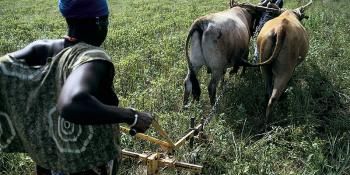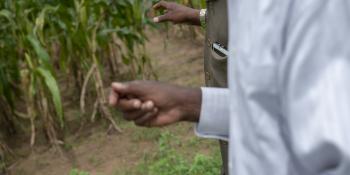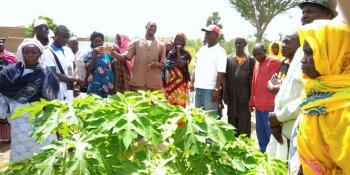Our common future under climate change: lessons from East Africa
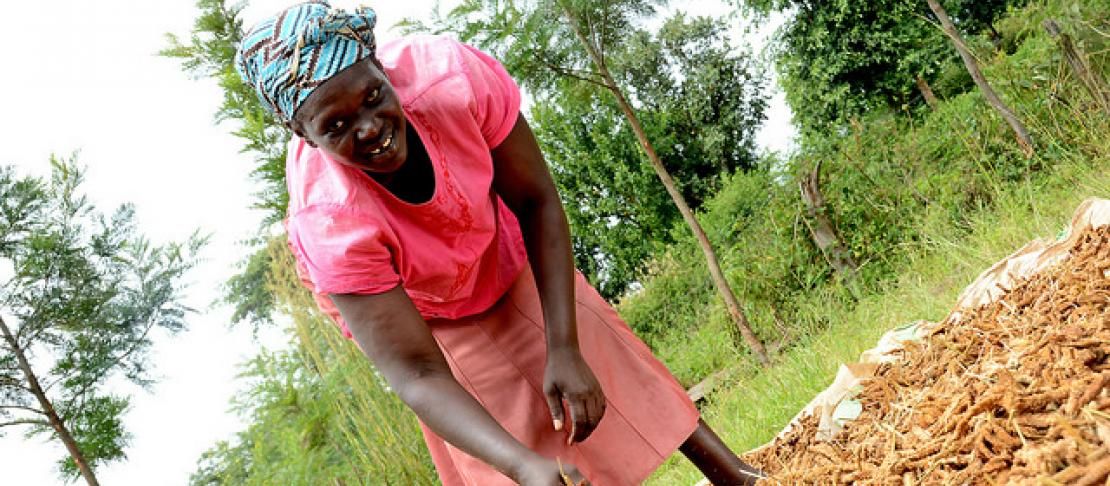
A snapshot of emerging research from East Africa shared during the Our Common Future under Climate Change (CFCC15) science conference in Paris.
“Science offers robust foundations for ambitious outcomes at UN Climate Change Conference (COP21) and beyond”. Thus reads part of the outcome statement from the scientific committee of the Our Common Future under Climate Change science conference (CFCC15).
As the largest international scientific conference held just four months before the COP21 in Paris, CFCC15 brought together close to 2,000 researchers who explored and discussed “current understanding of all dimensions of the climate change challenge, the full range of mitigation and adaptation options that can lead to sustainable, equitable solutions across all nations and regions”, as the outcome statement reads.
The CGIAR Research Program on Climate Change, Agriculture and Food Security (CCAFS), East Africa scientists attended the conference, sharing the following research findings:
Indigenous knowledge for seasonal weather and climate forecasting across East Africa (View poster)
This paper by Radeny et al. presents a synthesis of existing indigenous knowledge (IK) in weather forecasting across CCAFS’s four research sites in East Africa: Borana (Ethiopia), Lushoto (Tanzania), and Hoima and Rakai (Uganda). Farmers and livestock herders across these sites, use various local indicators to predict weather patterns, especially the onset, magnitude and cessation of the rainy seasons. These local indicators can be grouped into three categories: meteorological traditional indicators, astronomical indicators and biological indicators.
Meteorological indicators commonly used to predict onset of rains included appearance and colour of the clouds, direction and strength of the wind, temperature and humidity, lightning and thunder, and appearance of less dew on the grass and plants.
Astrological indicators included the alignment of the moon and stars, appearance and position of the moon, size and movement of the stars and were more pronounced among the pastoralists in Borana. In Lushoto, for example, the occurrence of a halo moon (moon surrounded by a yellow ring) indicates the likelihood of the onset of rains for the main and short seasons. In Ethiopia, traditional astrologists in Borana use seven stars (individual or in groups) locally known as Lemi that are believed to be very important for forecasting.
Biological indicators were further disaggregated into animal and plant indicators. Birds and insects are the key animal indicators. Some plants and trees are more sensitive to changes in atmospheric conditions than others. In Uganda, the sound from amphibians during day time and those of specific birds are used widely to estimate the likelihood of the onset of rain. Similarly, the sprouting of young shoots of the Mvule tree indicates onset of the rainy season in Uganda.
Farmers and herders use the above local indicators to make important agricultural production decisions such as timing of land preparation, types of crops to grow and planning for livestock mobility to reduce losses during drought conditions. The authors therefore recommended the systematic documentation of IK and a framework for integrating IK with scientific forecasting from the national meteorological agencies to improve the accuracy of climate forecasts for farmers in East Africa and increase farmers’ trust and willingness to use scientific forecasts in EA.
Additional reading: Integrating indigenous knowledge with scientific forecasts in Lushoto, Tanzania (Working Paper 103)
Engendering climate-smart agricultural innovations in East Africa (View poster)
This paper by Nyasimi et al. explores how men and women are adjusting their livelihoods and coping strategies at individual, household and village level in response to climate risks. Through interviewing 200 farmers, half of whom were women, and conducting four focus group discussions in Nyando, Western Kenya, the results show that women performed 65% of off-farm work during drought because only a few of them had property rights (25%) and hence could not sell or trade any household goods to make up fo food shortage gaps. In terms of perceived changes in weather-related shocks over the last fifty years, more women than men reported having observed floods, erratic rainfall and droughts.
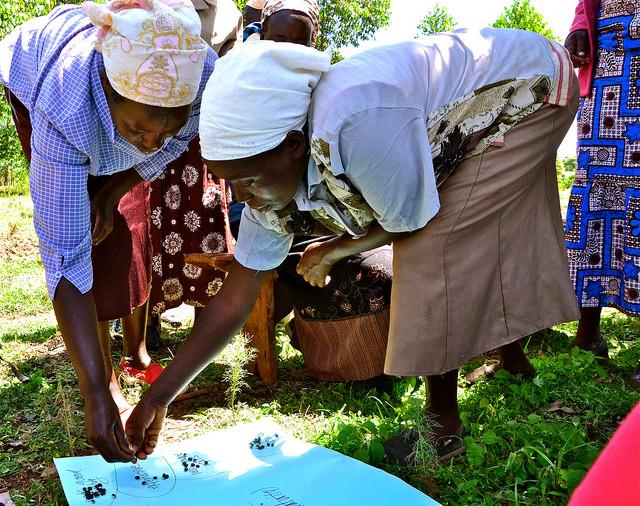
Gender differences amongst African societies persist particularly in social, cultural and economic roles and responsibilities. Photo: C. SCHUBERT
Additionally, this study shows that both men and women are adapting to the changing climate, and their changes are seasonal (short-term) rather than transformational (long-term). 64% of men and 57% of women reported to have made changes in their agricultural, livestock or livelihood practices in response to the climate risks. Most women reported that they ration foods and just a few of them reported constructing water pans to store runoff and for use during drier periods, selling baskets and ropes, altering crop varieties and planting dates. However, this is done after seeking consent from the heads of households. Without the power to decide on family resources, women’s ability to manage risks for example, by diversifying crops and livestock or altering planting dates is limited.
Overall, the researchers conclude that the most rapid uptake of climate-resilient farming was among women whose husbands were not available. This means the women had to make day-to-day farming decisions. The paper recommends that policy, strategy and investment responses at local and national levels must meet the specific needs of women and men.
Read more: Where women decide: faster adaptation, more resilience
Private sector actions to enable climate- smart agriculture in small-scale farming in East Africa (View poster)
In East Africa, little is known about the participation of private sector (small and medium enterprises, traders, farmer organisations, large-scale wholesalers, marketing boards and cooperatives) in climate-smart agriculture (CSA). This paper, by Quail et al. attempted to fill this research gap by examining patterns of, and incentives for, private sector investments in CSA at three pilot projects implemented by CCAFS East Africa in Nyando, Kenya; Hoima, Uganda; and Lushoto, Tanzania.
Using the social network analysis (SNA), the paper examines the relationships between private sector actors and farmers to visualise and interpret patterns of networks for information services for climate, crop and livestock extension, credit and banking, and legal. The paper further examines the supply chains of agricultural inputs and agricultural product value chains, and the local-level linkages with national agricultural organisations to determine if the latter play a role in facilitating the adoption of CSA.
Preliminary results suggest that independent traders dominate trade in all sites. Even though the supply of inputs is sufficient, farmers often lack access to credit. Also, distinctive differences existed in terms of the concentration of business activity amongst local actors and the diversity of marketable crops produced. The efforts of Kenya’s National Farmer’s Federation to establish locally-based farmer groups was reflected in its highly diversified groups that trade amongst themselves, in contrast to Uganda where a select few dominate locally traded agricultural output. Lushoto’s proximity to Dar es Salaam is evidenced in its high number of independent traders, and to a lesser extent, locally registered businesses. Despite its high level of trade, it is also the least food secure of the three sites.
While independent traders focus primarily on the trading of crops, they do disseminate information relevant to CSA. Efforts to strengthen this sector are therefore important.
The three presentations above demonstrate the different ways that farmers, herders and other agricultural stakeholders are addressing climate change in East Africa with three key recommendations:
- Farmers’ use of scientific seasonal climate forecasts can be increased if it is integrated with local indigenous climate forecasts (combining own experiences with scientific information);
- Climate change will inevitably lead to more women becoming land managers and decision makers and therefore, investment in human capital is critical to enhancing agricultural performance and productivity; and
- Knowledge sharing about CSA as an adaptation strategy must be provided to private sector to encourage investments
Maren Radeny is a Science Officer at CCAFS East Africa.
Mary Nyasimi is a Gender and Policy Specialist at CCAFS EA.
Sheryl Quail is a consultant with Selian Agricultural Research Institute (SARI), working closely with CCAFS EA in Tanzania.

